Replacing a gas meter: timing, procedure and rules for replacing a gas flow meter
Have you noticed that tasks such as replacing a gas meter are often taken lightly? Advisers post self-replacement algorithms and find dubious options for saving on devices and materials.
Meanwhile, replacement rules have a legislative basis and are dictated by the service life of the equipment. A person allowed to work must have confirmed qualifications: even changing the battery must be carried out by a gas service employee.
After conducting a thorough research, we found out the requirements for the procedure, found laws regulating the procedure, frequency and reasons obliging owners of gas equipment to replace the meter. We also found out what documents need to be provided to the service provider to replace the gas meter.
The content of the article:
Requirements of Russian legislation
Main document – resolution No. 824, approved by the Russian government on September 19, 2013.
It made changes to the Rules for the provision of public utilities and affected mainly the requirements for replacing gas meters.
Reasons for replacement specified by law
According to the law, it is necessary to replace an existing gas meter if:
- expiration of the service life specified in the technical data sheet of the product;
- negative verification results.
Negative results include visible mechanical damage, recorded error exceedances, broken seals, and lack of readable indicators.
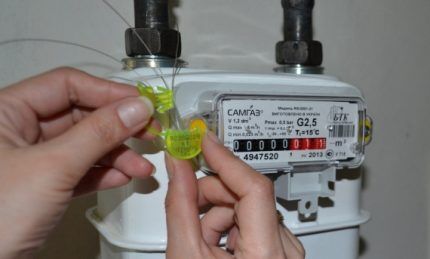
The initiator of the verification can be the owner who noticed a malfunction of the device, or a gas service employee performing a scheduled or extraordinary audit.
Performer and frequency
Important questions also raised by the resolution are: after how many years does the gas meter need to be replaced, and who should carry out the replacement? The frequency should be determined by the flow meter passport. Most models life time is 20 years. But there are also exceptions.
For example, a Betar brand product can only work correctly for 12 years. Therefore, verification with information from the manufacturer is mandatory.
The dismantling of the old device, as well as the installation of a newly purchased one, can be carried out by an employee of the gas service serving the area of residence. Representatives of a private licensed company can also get involved. Self-replacement is prohibited.
Who should pay for the replacement?
According to the Order of the Ministry of Industry No. 1815 dated July 2, 2015, payment for replacing the meter is borne by the owner of the premises. Depending on the type of property, payers can be legal entities, individual entrepreneurs or individuals.

Accordingly, these are owners of square meters in apartment buildings, owners of private households and holders of rights to commercial real estate.
The exception is municipal housing, where residence is temporary for citizens. In this case, the owner is the local government. Therefore, all costs are borne by the municipality. The only thing residents should do if a flow meter malfunction is detected is to file a complaint with the housing and communal services service.
Free service can be used by war veterans (veterans and rear service personnel), large families and non-working pensioners. At the local level, expanded lists may operate and additional benefits may be provided. You can check this information with your municipal gas company or local government.
Why is it important to monitor the status of the meter?
If the owner of the device promptly discovered its malfunction or violation of the integrity of the seal and notified the gas supplier about it on the same day, then during the replacement period payment will be made according to the standards. The replacement period lasts from the date of notification until the day following the date of sealing of the new/repaired meter.
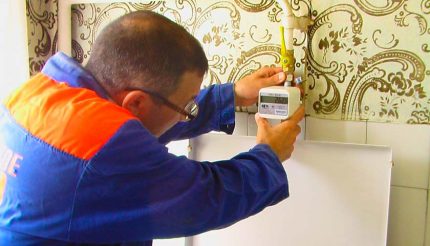
The situation is completely different when a gas service employee discovers a problem.In this case, the use of standards will apply to the period lasting from the moment of the last inspection until the installation of a fresh seal.
And, although the duration of the period cannot be more than 6 months, the increase in fees is very significant - as is known, the standards are too high compared to the volume of actual consumption.
Procedure for replacing equipment
The first stage of the algorithm for replacing the metering device is concluding an agreement with the company that supplies gas to the area of residence. The subject of the agreement is a set of measures to replace the device. Motive - an application submitted by the owner of the premises.

Private gas companies operate in large cities. They have the appropriate licenses, and their employees are certified and authorized to work with gas equipment. When contacting them to change a flow meter, you must request supporting documents.
First visit to a specialist
At the first visit after concluding the contract, the technician must confirm or deny the need to purchase and install a new device. There are often situations when, to restore functionality, it is enough to install a new battery or perform inexpensive repairs.
If the device is really outdated or broken, then a specialist must inspect the installation site, evaluate the technical conditions and give detailed recommendations on choosing the appropriate model. Based on these recommendations, the owner of the premises purchases a metering device and prepares for the second visit of gas service employees.
Second visit - installation
For the second visit of the specialist, it is necessary to prepare documents relating to the newly purchased device, as well as make room for installation. Since the meter must be installed in a visible place and in an area of free access, it is worth removing all obstructing objects.
This requirement is specified in SP 42-101-2003 – a set of rules for the design of gas distribution systems. It is necessary to follow it after installation, during operation: the meter must be located where it is convenient to install and maintain it.

After completion of installation, gas workers are required to fill out a certificate of completion of work and issue a document confirming the launch of the device. These documents must be kept along with the technical data sheet of the device.
The procedure algorithm for those living in an apartment is no different from the procedure for replacing a gas meter in a private house. The only addition for owners of private households is a gasification project.
The final replacement cost consists of the price of a new device and installation costs. An increase in the average value may be affected by:
- the need to increase the length of the gas pipeline using additional pipes;
- welding work;
- purchasing parts and consumables.
A more expensive replacement will be made by changing the position of the meter. For example, when moving the device into view.
Rules for sealing the meter
According to government decree No. 549 of 2008, only supplier companies are granted the right to install seals.However, it is not the emergency dispatch departments that install the devices themselves that are responsible for this, but authorized employees of subscriber departments. Therefore, for sealing you will have to write another application.
It should indicate:
- Full name, passport details of the owner of the property;
- brand and serial number of the device;
- flow meter readings at the time of installation;
- date of the next verification.
The application must be accompanied by a technical passport of the new device, an installation certificate, and a document on putting the equipment into operation.
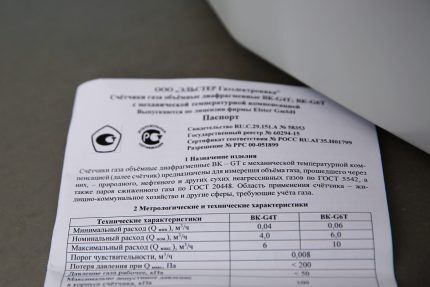
If the installation was carried out by a representative of a third-party licensed company, then it is necessary to present documents confirming the qualifications and right of the representative of this company to work.
Installation quality control
Work must be carried out taking into account safety rules:
- The distance from the meter to gas equipment cannot be less than one meter.
- Outside the home, the device can be installed under a moisture-proof canopy or inside a metal cabinet.
- The standard placement height is 160 cm. Any deviations must be confirmed by the technical data sheet of the product.
- There should be no heating devices within a radius of 2 meters.
- The device must be within visibility and easy access.
- The distance between the meter and the wall should be more than 5 cm. This ensures natural ventilation and slows down the formation of corrosion on metal parts.
- Upon completion of installation, a leak check is required. Previously, this was done by applying a soap solution.Now representatives of gas companies are increasingly giving preference to electronic sensors.
Knowing how to do it right install a gas meter in an apartment or house, it is easy to control the actions of specialists. In addition, an informed owner will be able to correctly formulate emerging questions and receive comprehensive advice.
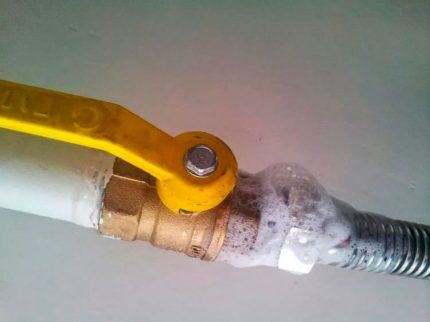
After installation, you should monitor the further operation of the device: while maintaining the same volume of consumption, the new device should record approximately the same consumption as the old one. If the readings vary greatly, this is a reason to contact the gas workers again.
Choosing the right model
The choice of specialists is based on the size of the room, the location of gas equipment, and the number of devices connected to the metering device. Craftsmen take into account the diameter of the thread and the throughput of the flow meter.
The user is advised to pay attention to the balance between price and service life, as well as the date of manufacture. A production date that is too old will significantly shorten the period until the next verification, since this period is determined by it, and not by the date of purchase or installation.
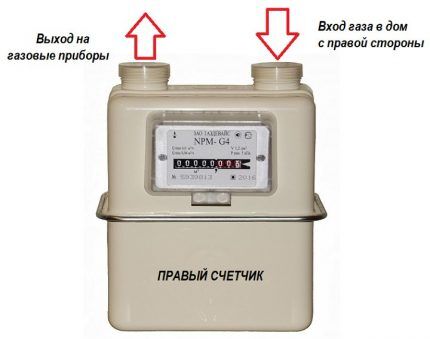
It would not be superfluous to clarify the design features, as this affects the frequency of verifications. Thus, compact rotary models must be inspected every five years.Membranes are subject to professional inspection every 10 years. Turbine devices frequently used in the industrial sector - once every 8 years.
The model chosen by the owner independently will, in any case, be checked to ensure compliance with all requirements. Therefore, before purchasing, you should consult with gas specialists.
The subtleties of choosing gas meters are described in more detail in this material.
Replacing the device battery
The need to change the battery is usually indicated by a blank screen. In some cases, some of the numbers become difficult to distinguish or “disappear.” Sometimes users notice the screen flickering, which may also be evidence of a faulty battery.
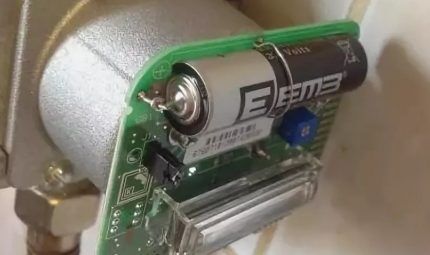
In this case, you will also have to turn to the help of the gas service, since opening the device yourself is prohibited. Moreover, most batteries are sealed.
Repair or replacement?
In some situations, replacing equipment may be more cost-effective than verification and repair work. If the device breaks down, you will have to pay for the dismantling work, examination and, if it is impossible to restore correct operation, a new flow meter and its installation.
Moreover, all the time spent on these manipulations, gas fees will be calculated based on regional standards.
Therefore, many users who suspect a major breakdown of the device prefer to immediately install a new meter.The old one is either disposed of or, after successful repair, stored as a spare until the end of its service life.
Conclusions and useful video on the topic
The meter is replaced when it breaks down and at the end of its service life. The initiator can be the owner himself or a representative of the gas service. When choosing a device, you should listen to the opinion of a professional, since only he can take into account all the technical details.
Installation should also be entrusted to specialists. This is roughly how their installation visit goes:
After completing the work, the gas service employee must draw up two reports: on replacement and on putting the device into operation. After this, all that remains is to put a seal and monitor the condition of the new flow meter.
Do you have anything to share with other flow meter owners? Write using the form below. It is also possible to attach photos, scans of technical passports, write comments and ask questions. Exchange of opinions is an opportunity to get useful tips, join us.




Please tell me whether the workers need to be paid extra if, when replacing a gas meter during installation, the worker tightens the nut when tightening it and it cracks. The next day we were forced to buy a new set of adapters for gas meters and pay for the work to replace them, although the amount for replacing the meter had already been paid
I am a pensioner 1.5 km to the station, 40 minutes by train. 1.5 km to the office. and so on twice.
To replace an expired gas meter, the subscriber must be given regulations for his actions and a list of necessary documents. Gas workers come once a year and supposedly service the entire in-house gas system. T.That is, they already have ALL the latest gas technical information for the subscriber. Why must the subscriber come with a civil passport and personally write an application for a replacement? The passport and application are complete nonsense and an obvious overkill. What difference does it make to gas workers who pays for their work, if I bought the meter, brought a copy of its passport, and paid for the replacement costs. My first visit ended with a trip to get my passport. Like, we don't know who we're talking to. The second is obtaining permission to replace the meter, paying for reinstallation. The third is receiving an application form for sealing and going home to get SNILS and TIN and filling out the application form accordingly. Fourth - successful submission of the application, a copy of the new meter’s passport and an appointment for sealing. I'm not even saying that you have to wait SEPARATELY for the visit of the installers and the visit of the sealer. When the gas workers were asked to optimize this routine operation by handing, or better yet, handing over with a receipt and notification of the need to replace the meter, the subscriber a list of the sequence of his actions and a list of NECESSARY papers, I heard that this is an approved procedure, that this is not a market and that the owner of the meter is me, and therefore my problems... To replace a gas meter, the subscriber or his representative (grandson, brother, godfather, matchmaker, neighbor) must make only ONE visit to the gas service. Hand in the pre-prepared papers and pay the required amount. Gas workers must come ONE time, install everything and seal it right away. It is clear that there are technological regulations for work, there is a flow of documentation within Gazprom’s structures.But WHY do I need to study all this and walk with my feet along the entire conveyor? Is it customer-centric? Imagine the ORDEAL of a client fifty kilometers away from Gazprom’s offices. ... Described all this on their website. No answer, no hello.